During 1942, the 1st Battalion had been involved in heavy fighting in North Africa and, after the fall of Tobruk, on 21st June 1942 most of the Battalion was captured and imprisoned in a POW cage, which housed some 30,000 men. However, a small number of men evaded capture and it was from these that a small cadre was selected, including Captain Richard Dray MC to return to England.
Lieut.-Col. W. R. ‘Willie’ Cox (later Brigadier) commanding the 11th Battalion had great influence at the war office, and arranged for the 1st Battalion to be reformed around the established and well-trained structure of the 11th Battalion.
On the 1st January 1943 at Pinner near Harrow the 1st Battalion of the Worcestershire Regiment was reborn when the small cadre of two officers and ten men from the original battalion marched into the centre of the men of the 11th Battalion carrying their Colours. The 11th Battalion was now disbanded and so became the new 1st Battalion. The 11th had previously moved to Harrow a month earlier on the 5th December 1942 and already had their headquarters in the town.
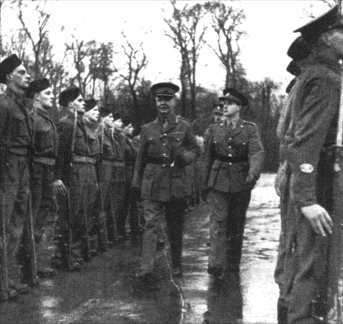
Brigadier-General Grogan VC with Major John Tomkinson
inspecting the reborn the 1st Battalion of the Worcestershire Regiment
(1st January 1943 at Pinner near Harrow)
On the 5th January 1943, the 1st Battalion Colours were once again laid to rest in Worcester Cathedral where they would remain for the next 3 years.
The Battalion remained at Harrow for the next 6 months where they trained and received their equipment. At this time they were part of the 33rd Guards Independent Brigade Group.
In September 1943 it was with great regret that commanding officer, Lieut.-Col. Cox left to take up an appointment at the War Office as a General Staff Officer. He later became General Officer Commanding, lines of communications troops for 21st Army Group – then a Major-General.
Lieut.-Col. R. B. Moss MBE arrived to take command and at the same time the Battalion left Wanstead and moved to Maresfield Camp in Sussex where they were housed in Nissen huts. However, this type of accommodation was not much appreciated by the troops.
During February 1944 the Battalion moved for a while to billets at Worthing where they trained daily on the South Downs with live ammunition and all types of fire arms. After a few weeks the Battalion moved back to barracks at Hythe where fire arms training continued on the rifle ranges.
In June 1944 the Battalion was at Heathfield where they continued their training in preparation for 'D' Day. On the 7th June all the Officers and Warrant Officers attended a Divisional Conference at Hastings, and personal messages were received from General Montgomery, also a message from General Eisenhower. On the 9th June the riffle Company's were issued with maps.
On the 11th June, Brigadier Essame (214 Brigade commander) visited the Battalion and gave a talk to all the troops.
On the 12th June, orders were received for an advance party to move. The party consisted of Capt. Ratcliff, Lieut. Langhton, four Lance Sergeants and one Private. The Battalion was now on 6 hours notice to move as from 18.00 hours. All money over 10 shillings per man was changed into French currency.
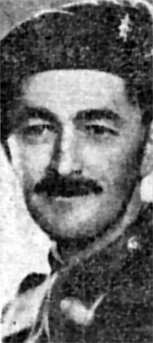
Lieut.-Col. A. R. Harrison
On the 14th June 1944 orders were received for the Motor Transport party (337 men) under the command of Captain Roose left to join the 214 Brigade column at Tilbury docks in London. The party left Heathfield at 08.30 hours on the 15th June and arrived at the marshalling area north of Tisbury at 14.00 hours. Included in this party were the Battalion Second-in-Command, Major George Taylor plus one Subaltern and men from ‘A’ Company. They remained there for the next 3 days preparing to embark for Normandy.
On the 15th June 1944 the main marching party of the Battalion under the command of Lieut.-Col. Roy Harrison, left Heathfield and travelled to Filham Park near Glyndebourne, which was the marshalling area for Newhaven. This was a tented camp, which had previously been occupied by the 15th (Scottish) Division. Other occupants of the camp were the 5th Duke of Cornwall Light Infantry (DCLI) under the command of Lieut.-Col. Atherton, and a small group of the 214 Field Ambulance.
The order to move was received and the Battalion marched out of the camp at 07.30 hours on the 16th June and were transported by troop carriers over the South Downs, in high winds, to Newhaven where they debussed and marched to the quayside. The whole of 214 Brigade was now in the harbour where the men were issued with a cup of tea.
Shortly after arriving the Worcestershire men proceeded to embark into Landing Craft Infantry (LCI) vessels, 201 men on each. Some 130 bicycles of ‘D’ Company were also loaded with some difficulty. With all on board the men waited to move out of harbour – but this was not to be.
After spending some time on the LCI,s in cramped conditions, and due to the delay because of bad weather the men were allowed ashore to stretch their legs. Together with some men of the DCLI, the battalion marched to a Camp about a mile away where they were able to rest and wash-up. However, early the same evening about 17.30 hours, the men were just settling down and drinking tea when suddenly the Embarkation Staff Officer appeared and explained that the Battalion were required to re-embark onto a larger ship. The men then marched back quickly to the quayside and proceeded to re-embark onto the ship SS Canterbury. In peace time this ship was in service with old Southern Railway Service as a passenger ship to the continent.
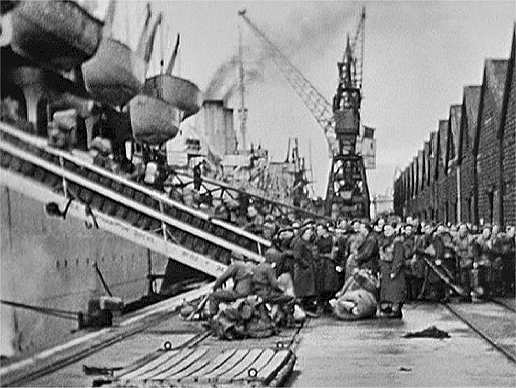
Boarding the ship at Newhaven
The SS Canterbury was already full of Canadians who had to disembark, none too happy because they had just bedded down for the night. The next problem was to retrieve the 130 bicycles from the LCI and load them on to the ship. With all men and bikes finally on board the ship was ready to sail and when darkness came left harbour and moored at sea just off Newhaven.
The next morning, 17th June, the ship was still at anchor with still no sign of a move. Although the sea was rough the weather was nice and bright and it was decided to do some physical training on deck – at least for all ranks who were not suffering from sea-sickness! Late in the afternoon the ship put back into harbour to take on fresh water.
The same day at 05.30 hours the vehicle party at Tilbury Docks commenced loading on to the transport ship 'MT48' (Empire Duke), the ship finally sailed on the 18th June at 14.30 hours.
Finally, late in the afternoon on the 18th June orders were received to set sail and the ss Canterbury with the marching parties and the commanding officer left Newhaven on the 19th June. The ship left its anchorage and proceeded to the Solent, where it was join other vessels in preparation for crossing the channel. By dusk the ship was just off the Isle of Wight and at anchor once again. It now became clear that the channel crossing would not take place that evening and so all ranks received at tot of rum with their cocoa before bedding down for the night – this was thanks to Captain Walker, the ships captain, who reminded the Battalion’s Commanding Officer that since the men had been on board for twenty-four hours they were entitled to a Navy ration of rum.
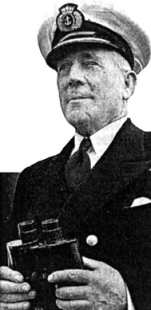
Captain G. A. Walker
It was the originally intended that the 43rd Division should have completed its landing on the Normandy beaches during the 20th June. However, the storm conditions made this impossible.
At mid-day on the 22th June, the SS Canterbury set sail again as the leading ship in a convey of five and proceeded towards the French coast. This convey was one of the first to cross the channel since the recent heavy gales and the sea was still very choppy.
During the voyage many German V-1 Flying Bombs were seen and some were even shot down by the ships Anti-Aircraft guns.
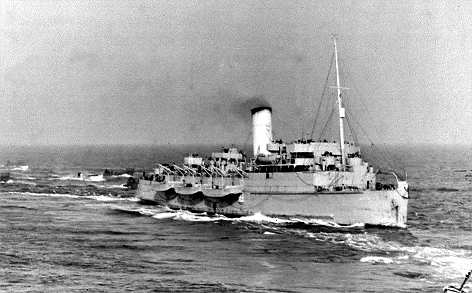
SS Canterbury heading towards the Normandy beaches
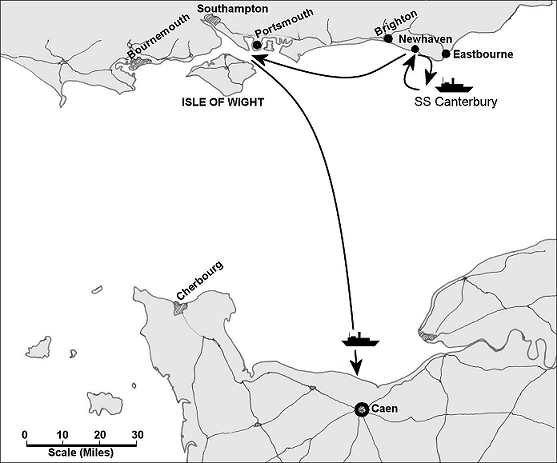
Movement of the SS Canterbury between 16th to 22nd June 1944
Normandy Landing and First Battle
In the afternoon of the 22th June, the Worcestershires got their first view of the Normandy coastline, where a vast array of shipping was gathered. On their left side was the battleship H.M.S. Rodney firing its 16-inch guns in the direction of Caen, and on the right was the Mulberry harbour at Arromanches still under construction having been severely damaged by the recent storm.
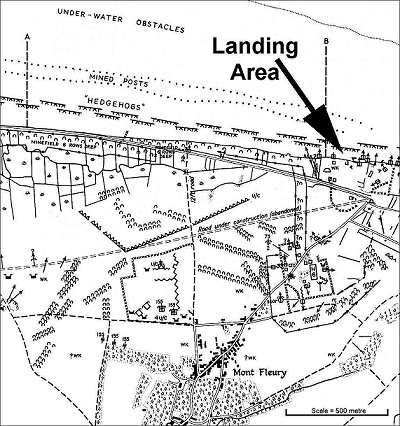
Location of 1st Battalion Worcestershire beach landing area
The SS Canterbury was ordered to stand-off and wait for orders to disembark, eventually the 1st Battalion Worcestershires were given the go ahead to board four Assault Landing Craft and head for the beach. The designated landing area was some 3 mile east of Arromanches near the small village of Mont Fleury, and at 17.15 hours the first LCA, with the Commanding Officer (Lieut.-Col. Roy Harrison), came ashore. As one of the other LCA’s beached a naval rating lowered the bow ramp and signalled for the first carrier to drive off, but the commander of the craft asked for the sea depth to be checked. This was very fortunate since the measure failed to touch the sea bottom, and so the landing was temporarily halted. Before a second attempt was made to try to get closer to the beach, orders where received stating that no more landing should be made that evening. As a result one of the LCA’s moored alongside a naval vessel and did not disembark until the following morning.
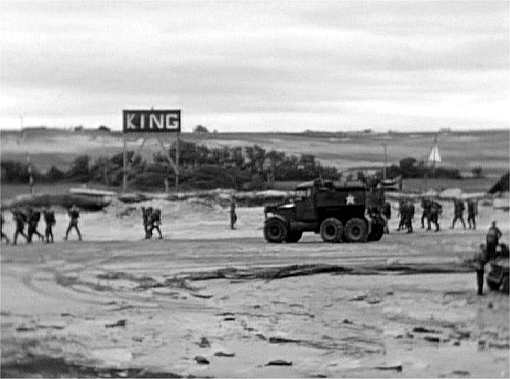
King Beach landing area on Gold sector
Lieut.-Col. Harrison recalls;
“We set foot on the beaches at 5.20 p.m. in the evening and immediately moved off inland about a mile. Our first reception on the way was a Flying Fortress, which lost a wing and crashed a short distance off – most of the crew bailing out. Our fighters were very busy round the Caen area, and the flak was heavy. As darkness fell, enemy aircraft came out just off the beaches, and the tracers that went up from the ships and elsewhere was a real firework display.”
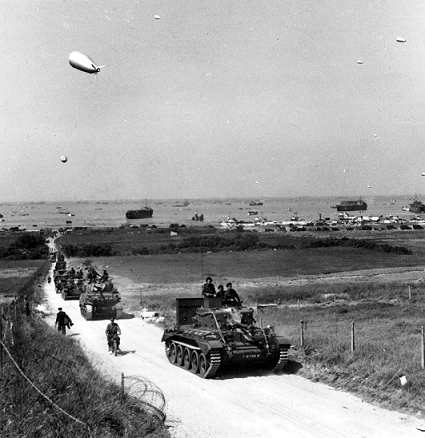
Moving up from King Beach
At about 20.00 hours orders were received that the Battalion was to move to a concentration area south of Manvieux (map reference 8286), and that Troop Carrying Transport would collect us. This was not very far, and it was hoped that we would march, but in due course the transport turned up under a young subaltern who professed to know the way. The column consisting of First Battalion The Worcestershire Regiment and 5th D.C.L.I. moved off into the darkness and went on and on and on. After some two hours it halted and it was then found that the subaltern had gone on ahead to find his way. He failed to return, and after much scratching of heads it was decided that we were just north of Bayeux. Threading our way through this place we eventually arrived, just before dawn, in the new area but with the subaltern still missing.
The Brigade Advance Party had arrived but there was no sign of the Battalion Advance Party, nor of Brigade Headquarters, nor of the M.T. Party. The day was spent digging in and having the first meal off the 24 hours pack, which, all agreed, could have been cut down to about half the size. A message came through that the Corps Commander, General O’Connor, was holding a conference for Commanding Officers that afternoon at Creully, and Lieut.-Col. Atherton and the Commanding Officer went there, but there was still no sign of the Brigadier, nor of Lieut.-Col. Beasley.
The Line at this time ran through Caumont on the right—Tilly (map reference 8368)—Cheux—thence northwest along the beachhead side of Carpicquet Aerodrome and Caen. 50 Division was on the right, the Canadians in the centre opposite Cheux and Carpicquet, 3 Division on the left north of Caen, and Sixth Airborne Division rather hemmed in on the east side of the River Orne but keeping the left flank secure. At this conference it appeared that 8 Corps, to which the Division had been transferred and which included 15th (Scottish) Division and 11th Armoured Division, were to attack on Monday with a view to seizing the crossings of the River Odon and the high ground at Point 112 —west of Caen. Having secured these the armour was to pass through, seize the crossings of the Orne and then debouch in the open country to the south with the hope that the Boche would then get out of Caen. The initial attack was to be made by 15th (Scottish) Division from Le Mesnil-Patry and Norrey-en-Bessin with objectives Cheux and St. Mauvieu. Having seized these two places, 11th Armoured Division was to pass through and seize the crossings of the Odon round about Mondraiville, passing on to Esquay and Hill 112. Meanwhile 43rd (Wessex) Division were to take over from the 15th (Scottish) Division at Cheux and St. Mauvieu.
The operation was given the codeword “EPSOM” and there was talk of a good gallop.
The next day the Divisional Commander gave his orders which consisted of the move to a concentration area west of Brecy (map reference 8778) on the following day, Monday—214 Brigade would be the leading Brigade of the Division taking over from 15th (Scottish) Division at Cheux and St. Mauvieu. Thus the Brigade were to have the honour to be the first troops of the Division to be committed.
The take over was stated to be going to be a simple one, as the only opposition that was expected was from Carpicquet Aerodrome, which was strongly held and overlooked Cheux. This Aerodrome was going to be completely neutralized during the take over by a force known as the Metropolitan Air Force. No one knew what this amounted to or what it was. Secondly, it was disclosed that the enemy Division holding the immediate front was the Hitler Jugend Division, who were young fanatics, and as they had been up to all sorts of low-down tricks against the Canadians, we as a Division were to take no risks with them and no quarter was to be given.
The move to Brecy was made by march route along roads packed with vehicles and cloaked in clouds of dust, and the Battalion moved in in the afternoon still minus the M.T. Party with the operation due to commence the next morning. The M.T. Parties of 5th D.C.L.I. and 7th Somerset Light Infantry had turned up in the morning and eventually, after tremendous efforts by the Brigadier and Army, it was discovered that our M.T. Party was still lying off the beach where it had been for five days getting thoroughly sick. They had not been allowed ashore because they had embarked as part of 12 Corps, which at this time bad lowest disembarkation priority, and neither the Captain of the ship nor Capt. Roose knew of the switch over of the Unit to 8 Corps. They were, however, eventually disembarked and started coming into the concentration area in the late afternoon. Great credit was due to all of them for they came ashore 100 per cent in vehicles and all turned up in the concentration area—no mean feat with the roads so knocked about and unsignposted. Personnel had to be sorted out, the various ranks of the Rifle Companies had to return to their Companies, and M.T. personnel who had crossed with Rifle Companies had to return to the M.T. Finally, all vehicles had to be completely dc-waterproofed during that night so as to be ready for operations next morning. By nightfall everyone was dug in except some M.T. personnel who had to go on with their dc-waterproofing all night.
MORE INFORMATION WILL BE ADDED SOON